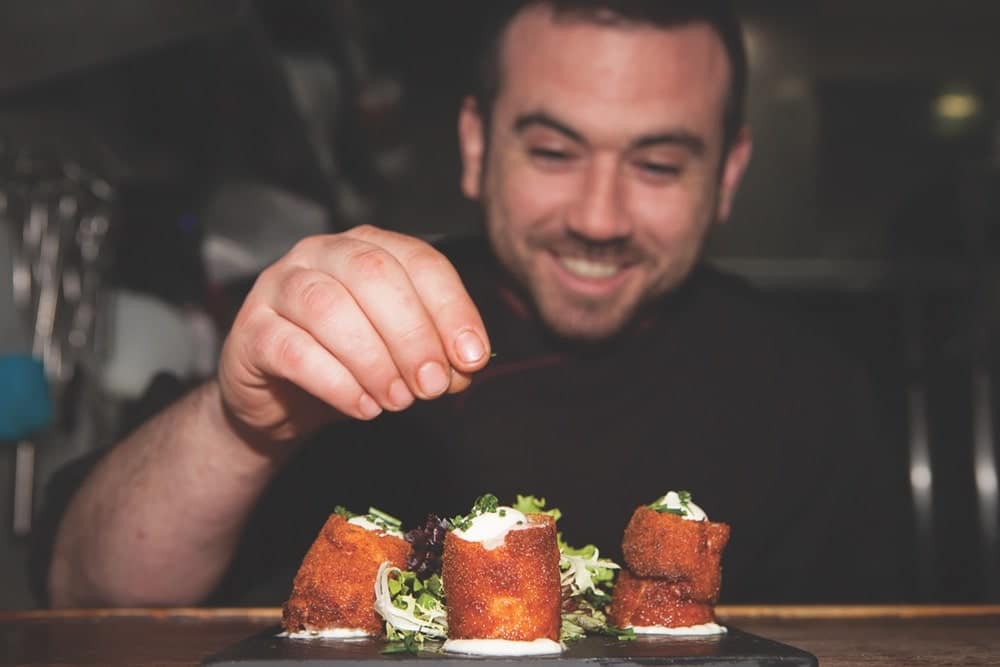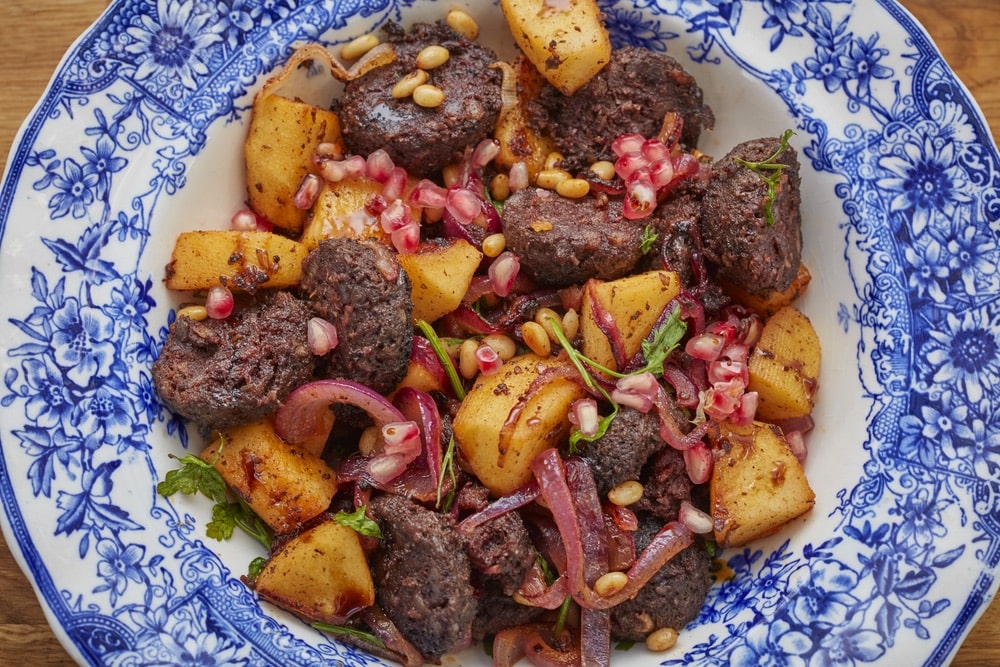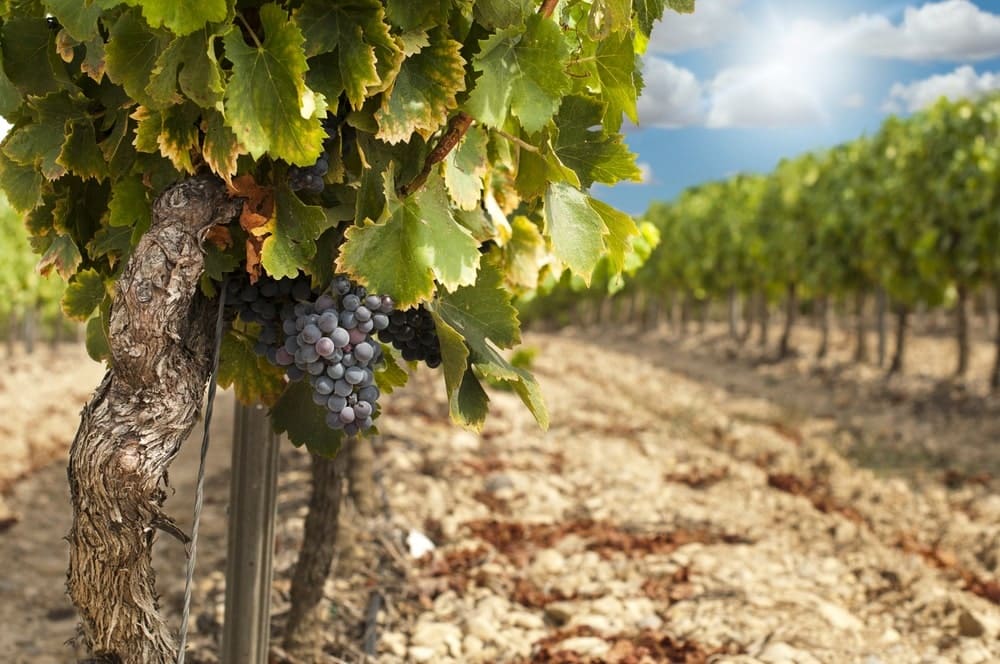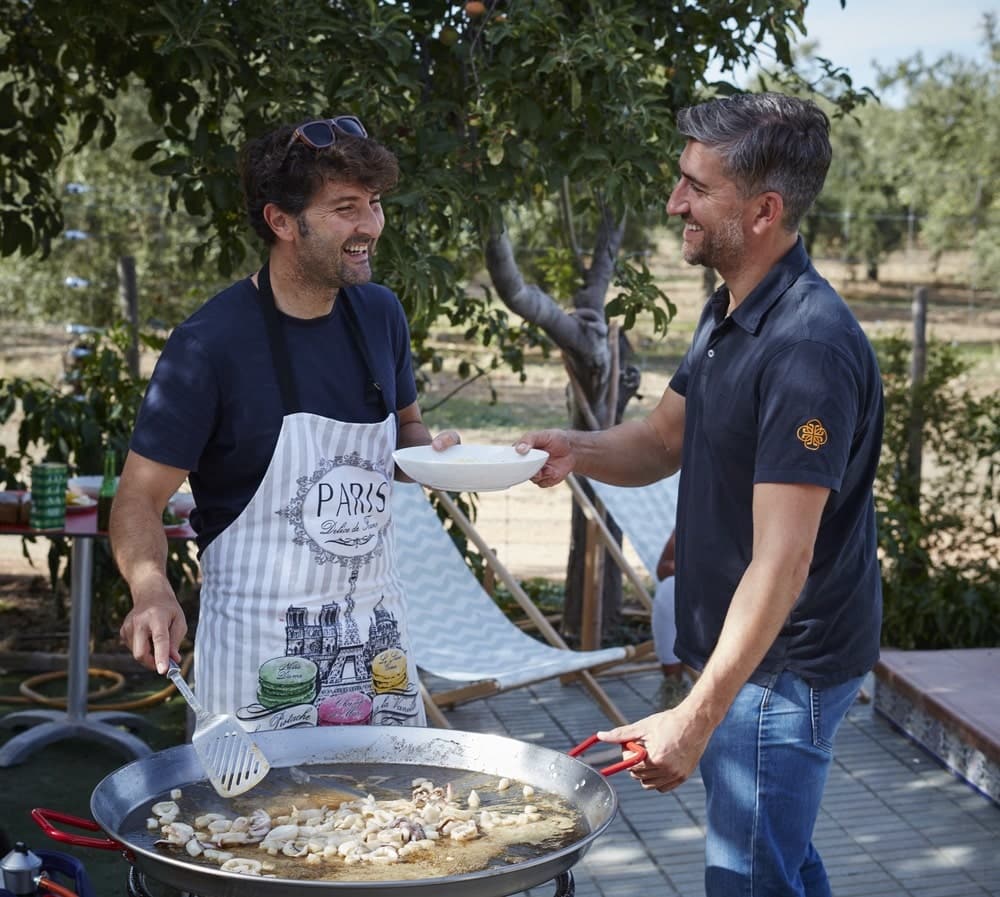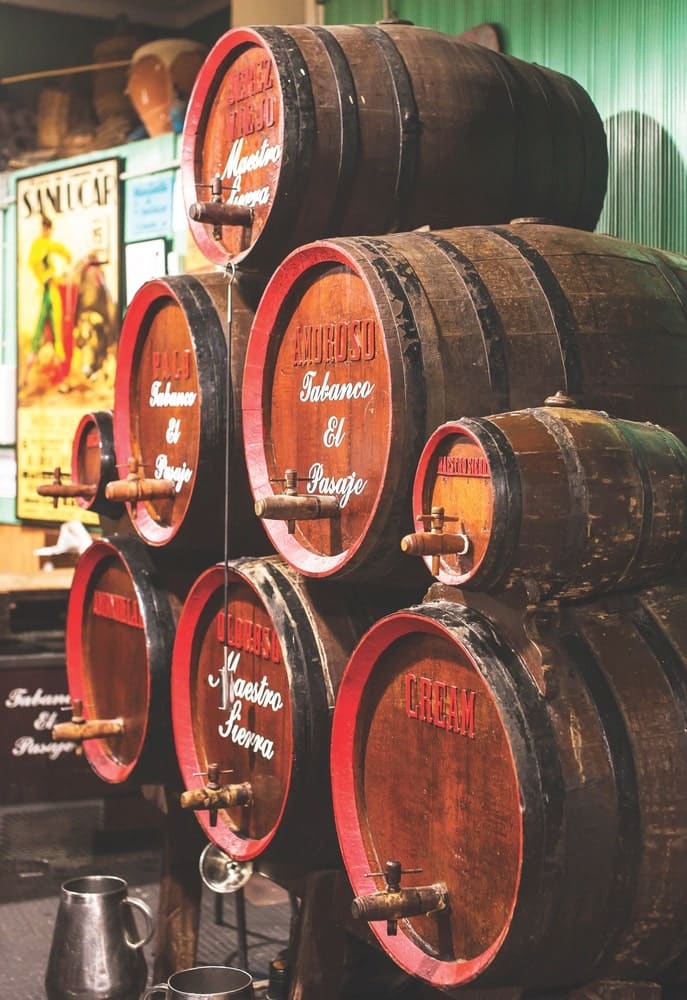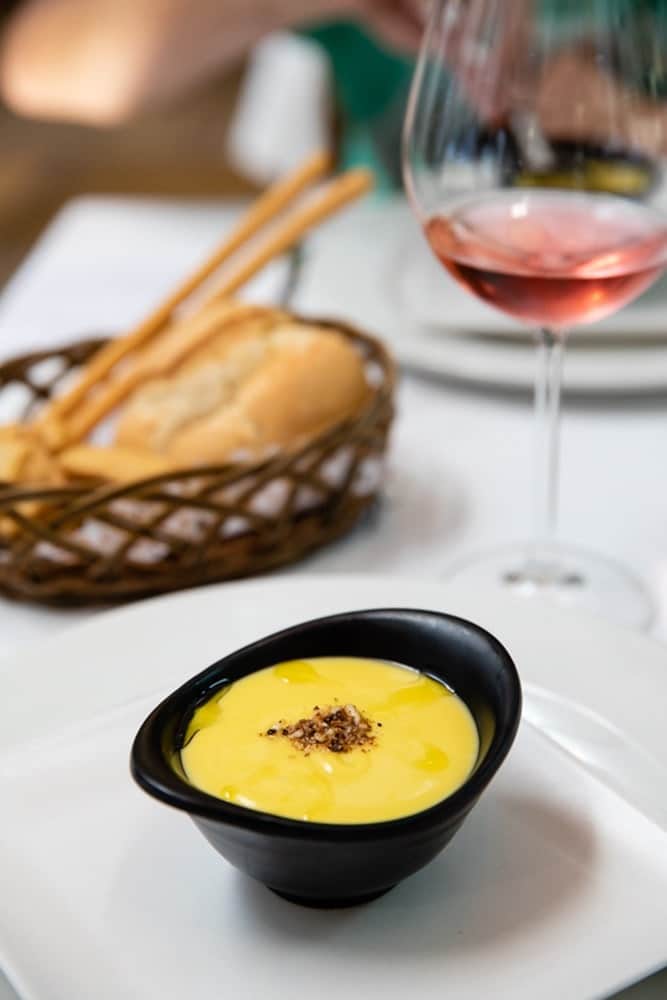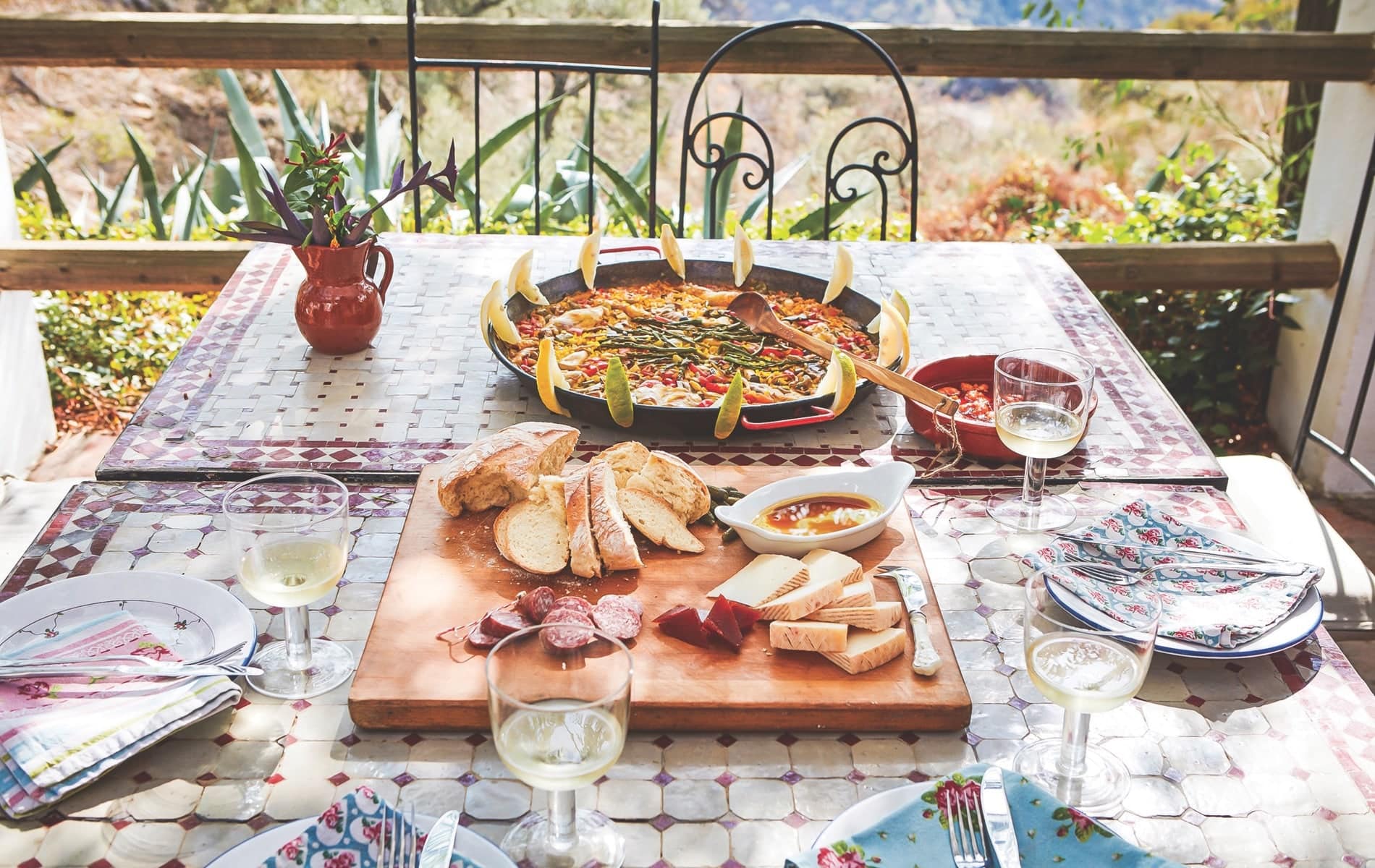
vie-magazine-toma-and-coe-andalucia-spain-hero-min
A seafood paella preceded by cheese, charcuterie, and bread with good olive oil is the quintessential Spanish celebration feast.
Seafood and Spice and Everything Nice
By Anthea Gerrie | Photography courtesy of Toma and Coe
Who knew the most popular dish in Spain’s tapas bars would be not the paella, the tortilla omelet, or the premium ham made from acorn-scoffing pigs for which the country is famous, but—Russian salad? It took an expert on Andalusian cuisine to point this out as we traveled from one bar to the next across the country’s beautiful south in search of the province’s regional delights.
“No two ensaladillas rusas are ever alike—and when we made a stop in the region of Extremadura, we were horrified to find it’s not a staple at all!” laughs Manni Coe of specialist Spanish tour operators Toma and Coe. He loves nothing better than to share his favorite bars, restaurants, and producers with increasing numbers of visitors drawn to Spain by the country’s reputation for the most exciting food in Europe.
The company’s focus is Andalusia, the land of flamenco, bullfights, and the fabulous Alhambra. It’s known more for its iconic cities—Seville, Granada, Córdoba, and Málaga—than its regional fare, but there’s more to the province than gazpacho, the refreshing cold soup of blended raw vegetables or fruit, which can be found just about everywhere. One highlight is white gazpacho, a delicious alternative based on garlic, ground almonds, and green grapes; like all gazpachos, it’s always served chilled, particularly welcome when the summer heat creeps up into the nineties. Even more delicious is strawberry gazpacho, with the fragrant, ripe fruit replacing most of the tomatoes when in season. It works!
- Chef Fernando of Toma and Coe food tours puts the final touch on some Spanish tapas.
As for that ensaladilla rusa, you can always expect diced boiled potatoes and mayonnaise as a base, with pieces of tuna, prawns, or hard-boiled egg—or sometimes all three—and occasionally peas and carrots. It’s invariably served with a flourish from a ring mold, looking as white and fluffy as a mound of fresh goat cheese, the perfect sharing plate for two or three.
Andalusia invented the tapa—named for the snack in a saucer that was originally served covering a drink and usually complimentary. Today it’s the most fun and affordable way to taste Spanish specialties; the drink of choice to wash down tapas remains a dry fino or a rich oloroso. These excellent aperitifs are made in the Córdoba area, but those called “sherry” can only be labeled thus if they are made in the southwesternmost area of Spain around Jerez de la Frontera from which the sherry takes its name. This is also the land of great tuna, and the tuna capital of Barbate is a great draw in May, when visitors flock to the city to sample the freshly landed fish served in dozens of different ways.
He loves nothing better than to share his favorite bars, restaurants, and producers with increasing numbers of visitors drawn to Spain by the country’s reputation for the most exciting food in Europe.
While southern Spain is the most colorful area of the country with its rich and exotic heritage, thanks to Moorish invaders bearing culinary influences from Jewish and Arab settlers, the most exciting Spanish food today is in the north. The restaurants of northern Spain have dominated the top ten of the San Pellegrino World’s Best Restaurants list for its seventeen-year history; notably El Celler de Can Roca, the current number two, has won twice and never dropped out of the top three in eight years. It’s a worthy successor to Ferran Adrià’s El Bulli, which was a serial winner in the first few years of the contest.
Both the Roca brothers and Adrià cook in Catalonia, the latter in its fabulous foodie capital, Barcelona. Here, Suculent, in the edgy Raval neighborhood, is special; nearby—within a minute’s stroll of the famous Ramblas, right behind the theater—lies Bar Cañete, one of the world’s buzziest watering holes, with fabulous tapas served around a long, convivial, horseshoe-shaped bar. The Roca brothers, whose main restaurant is in Girona, have their own Barcelona outpost, Roca Moo, in the elegant Eixample district, where both the Hotel Omm and the Mandarin Oriental make lovely perches. The Mandarin Oriental fields its own fabulous tasting menus from multi-Michelin-starred female chef Carme Ruscalleda and her son, who heads up the hotel’s Moments restaurant.
- Sherry is aged in barrels in Spain’s westernmost province of Jerez de la Frontera, the region from which the drink takes its name.
Like Catalonia, Spain’s País Vasco (Basque Country) perches on the country’s northeast coast, and here the dining hot spots are the cities of San Sebastián and Bilbao. You only ever need to visit the bars of the old town to eat well in San Sebastián, famous for its “pintxos”—think more substantial and more exciting tapas. While Gandarias and A Fuego Negro are highly rated, a personal favorite is La Cuchara de San Telmo in a back street near the church (try the foie, served in a spoon with apple).
With food of this quality, it’s amazing that San Sebastián’s restaurants get patronized at all, but two of the country’s greatest chefs are at work here—Juan Mari Arzak (at Arzak) and Andoni Luis Aduriz (at Mugaritz). Despite the old-fashioned cottagey surroundings and veteran chef-patron, Arzak serves cutting-edge food and has held a coveted three Michelin stars for several years. A young upstart who has achieved his own three Michelin stars in nearby Bilbao is Eneko Atxa; his restaurant Azurmendi is as worthy of a visit as Frank Gehry’s fabulous Guggenheim Museum.
La Coruña, an elegant city of sparkling, glassed-in verandas, is the country’s unofficial octopus capital, and Mesón do Pulpo, off the handsome Plaza de María Pita, is a good place to try it.
By comparison, a fourth foodie corner of Spain—the northwestern province of Galicia—offers nothing but the country’s finest seafood and beef. La Coruña, an elegant city of sparkling, glassed-in verandas, is the country’s unofficial octopus capital, and Mesón do Pulpo, off the handsome Plaza de María Pita, is a good place to try it. The city of Santiago de Compostela, famous for its church, the world’s most famous site of Christian pilgrimage, is also renowned for its brilliant Galician beef, the product of elderly dairy cows in their retirement. And, although Galicia has a third lively city—Vigo, with terrific fish restaurants of its own—the finest seafood is to be had on the coast, in the coves of the glorious and wild Rías Baixas. The stars here are percebes—barnacles, much more delicious than they sound—and navajas, razor clams.
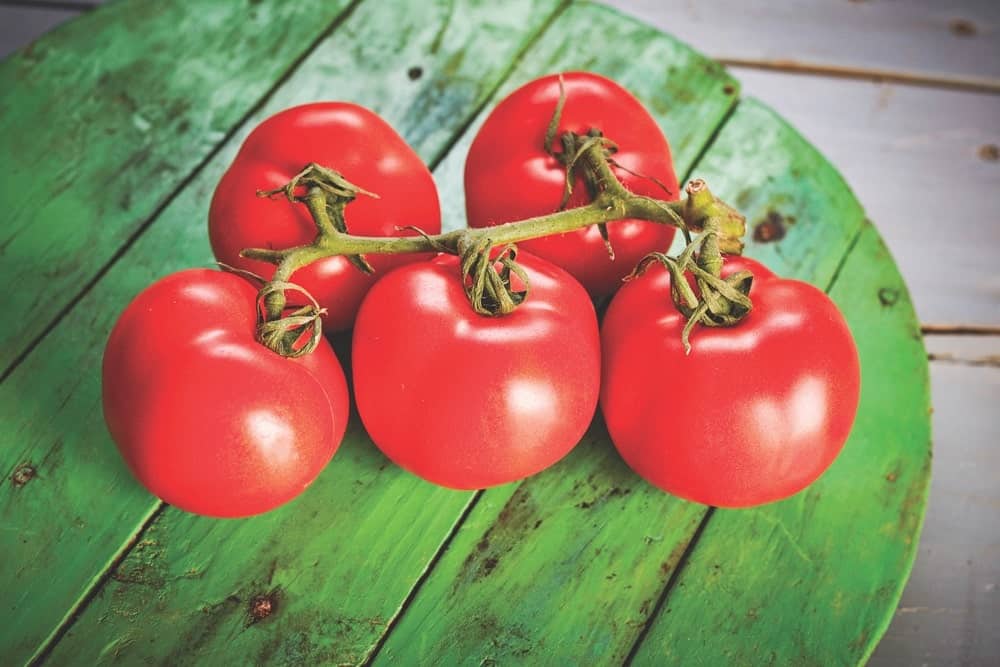
Vine-ripened tomatoes tasting of summer are the great glory of Spanish cuisine.
Galicia is also famous for its Albariño white wine, perfect for washing down the shellfish, and wine aficionados may want to venture into the Rioja region lying south of País Vasco just to enjoy the region’s superb wines. One of the most famous wine estates, Marqués de Riscal, is also home to Frank Gehry’s hotel, its titanium folds rising like a mini-Guggenheim above the plain. Rioja is worth exploring to visit a new generation of winemakers operating out of fantastically designed wineries, and when checking lists throughout Spain to order a bottle, make sure to explore the rich reds of Ribera del Duero as well as vintages from Navarra and Penedès.
And wherever you are, don’t forget to order a plate of jamón ibérico de bellota—the finest ham you’ll ever taste and the original product that won Spain its fabulous reputation for stunning food.
— V —
Toma and Coe (TomaandCoe.com) has a Secret Andalucía culinary tour departing Málaga on June 4, 2019, and will create bespoke food and wine itineraries for individuals and small groups.
Anthea Gerrie is based in the UK but travels the world in search of stories. Her special interests are architecture and design, culture, food, and drink, as well as the best places to visit in the world’s great playgrounds. She is a regular contributor to the Daily Mail, the Independent, and Blueprint.
Share This Story!
KEEP UP WITH THE LATEST STORIES FROM VIE



